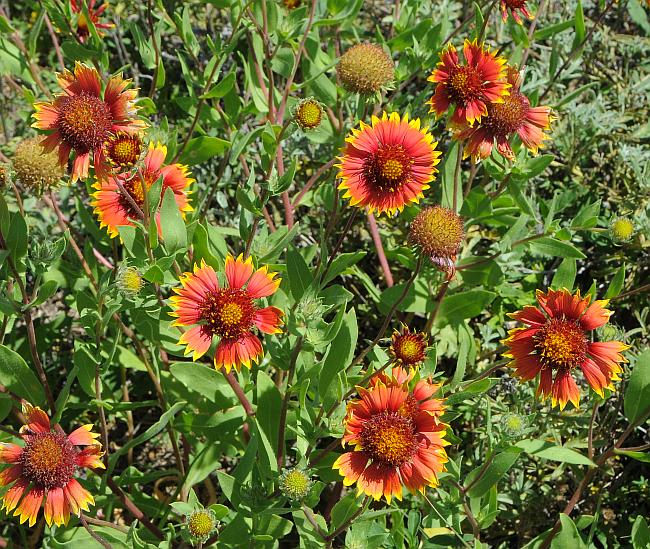Gaillardia pulchella Foug.
Indian Blanket

Introduced
CC = *
CW = 5
MOC = 9
© SRTurner
Gaillardia pulchella Foug.Indian Blanket | |
 |
Introduced CC = * CW = 5 MOC = 9 |
© SRTurner |
|
Family - Asteraceae/Heliantheae Habit - Annual forb, often taprooted. Stems - Ascending to erect, to 60 cm, few-to many-branched, finely longitudinally ridged, moderately to densely pubescent with curved or curled hairs, some of the hairs sometimes gland-tipped.
Leaves - Alternate and sometimes basal, long-petiolate to sessile. Basal leaves long-petiolate, the blades oblong-elliptic to obovate, usually with several blunt, pinnate lobes, tapered at the base, rounded or broadly angled to a bluntly pointed tip. Stem leaves short-petiolate to sessile. Blades 1-8 cm long, narrowly oblong-elliptic to lanceolate, those of the median and upper leaves more or less rounded and clasping the stem, rounded or more commonly angled to a bluntly or sharply pointed tip, unlobed or with few to occasionally several shallow to deep pinnate lobes, the margins otherwise entire, wavy, or toothed, the surfaces densely pubescent with short, curved or curled hairs, also dotted with sessile to impressed glands, usually somewhat roughened to the touch.
Inflorescence - Solitary flower heads at branch tips, the heads appearing long-stalked. Heads - Radiate. Involucre cup-shaped, 8-16 mm long, 18-28 mm in diameter, the bracts in 2-3 subequal series, lanceolate to narrowly lanceolate or narrowly triangular, the surfaces and margins densely hairy and usually also glandular. Receptacle strongly convex, with the florets subtended by numerous bristles, these 2-3 mm long, stiff, sometimes fused irregularly at the base.
Florets - Ray florets 6-15, sterile, with the corollas 15-28 mm long, red, brownish red, or reddish purple, sometimes yellowish toward the tip, the ligule usually with only the outer surface hairy and glandular. Disc florets numerous, perfect, with the corollas orangish red, purple, or purplish brown. Pappus of 6-8 scales, these 4-7 mm long.
Fruits - Achenes wedge-shaped, more or less 4-angled, 2.0-2.5 mm long, the surface densely pubescent with relatively long, yellowish, ascending hairs, black. Flowering - May - September. Habitat - Prairies, pastures, fields, roadsides, railroads, open disturbed areas. Also cultivated. Origin - Native to the U.S. Lookalikes - G. aristata. Other info. - This striking plant does not commonly occur wild in Missouri, though it is frequently cultivated. It has also been deliberately sown by highway departments, sometimes without much regard to genotype. As a result of these activities, the precise native range is somewhat obscure. Populations in Missouri's northwestern counties may represent native occurrences. The plant is much more common in the southwestern U.S. It is easily recognized by the appearance of the flowering heads, with red rays often tipped with yellow. Rarely the ray flowers are absent so the head will consist of just disk flowers and will be more globose in shape. Another Missouri species, G. aestivalis, differs in having ray flowers which are all yellow. Photographs taken in Bald-Head Island, NC., 5-12-02., and in Jacksonville, Fl., 7-4-02 (DETenaglia); also along Hwy 70 south of Matador, Motley County, TX, 5-19-2016, at the Ingalls US-50 rest stop, Gray County, KS, 6-4-2016, and at the Blue River fishing and hunting reserve, Johnston County, OK, 5-25-2023 (SRTurner). |